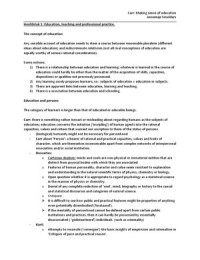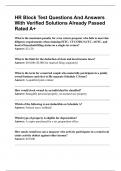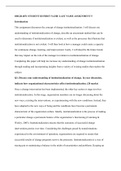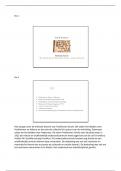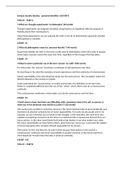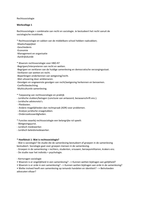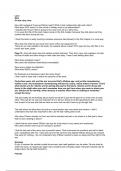Inhoudsopgave
Lecture 01 – Introduction................................................................................................................................... 1
Lecture 02 – Principles of psychopharmacology ............................................................................................... 4
Lecture 03 – The pharmacology of depression ................................................................................................. 6
Lecture 04 – Stimulants ..................................................................................................................................... 8
Lecture 05 – The pharmacology of anxiety ..................................................................................................... 12
Lecture 06 – Pharmacology of mood- and anxiety disorders, clinical perspective ........................................ 15
Lecture 07 – Cognitive enhancement .............................................................................................................. 17
Lecture 08: Antipsychotics ............................................................................................................................... 20
Lecture 09 – Clinical perspective on antipsychotics ........................................................................................ 23
Lecture 10 – Dependence ................................................................................................................................. 25
Lecture 11 – Psychedelics ................................................................................................................................ 29
Lecture 01 – Introduction
A drug or a pharmakon is an administered substance that influences psychological processes;
sometimes also body’s own substances but not when it is primarily a nutrient.
Psychoactive substances: influence processes in the brain and hence behavior, cognition, affect. They
can be used for different purposes: therapeutic and recreational.
SQ: Which two overarching classes of psychoactive substances can be discerned based on their use? -
-> therapeutic and recreational.
Pharmacology studies the influence of substances on biological processes. Psychopharmacology
focusses on their effects on behavior, cognition and effect, including their mechanisms in the brain.
Pharmacokinetics answers the question: How does a substance move through the body (how you
administer it, how easily is it taken in the blood?). This has to be distinguished from
pharmacodynamics that answers the question: To what receptors does the substance bind, what
effect does it have on the receptor?
Neurotransmission: neurotransmitters work on neurons via receptors: this are complex protein
chains. The most typical receptor is: postsynaptic.
Metabolite excretion is not a drug target to influence the functioning of neurons: metabolites does
not have an active part anymore, so there is no need to influence this process with a drug.
Neurotransmission – activation of receptors:
Intra- en extracellular space divided by a membrane. Potential difference inside/outside is +- 70 mV.
Neurotransmitters act on neurons via receptors. Effect: small change with respect to the resting
potential (EPSP/IPSP) that can add up to the threshold for an action potential.
Relatively few number of neurons: dopamine (DA), serotonin (5-HT), NE is used in <1%; hence,
relatively specific targets for drugs.
Frequent (50% of synapses): GABA, glutamate, endocannabinoid. This causes a specificity problem
for drug targets.
1
,What are the building blocks for neurotransmitters (=precursors):
SQ: What is not a precursor for
noradrenaline? --> Tryptophan
Types of receptor:
Pre-synaptic: axo-dendritic, this is the most typical type.
Pre-synaptic:
− Auto-receptor: detects release of neurotransmitter from own neuron
− Heteroreceptor: modulates synaps from another neuron
Auto-ceptors: on other locations on the cel, for example on a dendrite.
Types of neurotransmission:
Synaptic axo-dendritic is the most typical form, but besides this:
− Retrograde transmission
− Nonsynaptic diffusion (volume transmission)
Neuromodulators: endogenous benzodiazepine
Neurohormones: CRH (Corticotropine Releasing Hormone), HPA-axis: cortisol.
Ending of neurotransmitter activity can be through degradation (metabolism) in synapse and
reuptake within the cell. For example: ACh: degradation by extracellular enzyme AChE (then
reuptake). 5-TH: reuptake (and intracellular degradation).
SQ: From modulation of which neurotransmitter do you expect the most specifically localized effects
in the brain? --> Dopamine.
Points of engagement around the synaps for drugs:
2
, − Amount of transmitter: synthesis (presence precursor, activity of enzymes) or uptake of
transmitter in and release from vesicles.
− Blocking or modulation receptor (pre/post synaptic)
− Ending influence trough reuptake of degradation.
Registration of a new drug:
New compounds must be admitted by a regulatory board. For NL this is College ter Beoordeling van
Geneesmiddelen. For US this is the Food and Drug Administration (FDA). Registration for medications
base on research into efficiency and safety.
To be admitted by CBG/FDA: step one is preclinical phases (animal research precedes administration
in humans): efficacy (= animal models are not always predictive for effect in humans); administration
(=does the substance survive the gastro-intestinal system and blood-brain barrier?), safety (=are
there no serious side effects, even when administered systemically; see the therapeutic index).
Sometimes a drug is
save alone, but in combination with other substances can be very dangerous.
After the preclinical phases; the clinical trials in humans begin:
Phase 1: non-toxic, tolerable: is the substance safe? In this phase researchers test whether human
subjects (most often healthy volunteers) tolerate the substance).
Phase 2: limited efficacy studies: does it work? In this phase is tested if sufficiently safe, sick people
take the place of the healthy. Aim is now to test whether the substance really works against the
disease. Also: cost/benefit consideration.
Phase 3: large, multi-center studies: Does it work, and is it better than other existing drugs? When
the results in phase 2 are good, larger trials start with larger number of patients. In this phase, the
new drug is first tested against a placebo and then against existing treatment.
Phase 4: What are the effects in the long term: even after a drug has been registered,
The drug name:
− Chemical name/formula: N-Methyl-gamma-(4-benzenopropanamine)
− Codename: LY110140
− Generic name: easier to communicate: fluoxetine
− Brand name: Patent holder: Prozac; after the patent expires it is also sold o=under the
generic name.
SQ: What are the different names that are given to medications once they become available for
prescription, and what is the difference between the names? --> In the first phase only the chemical
3

